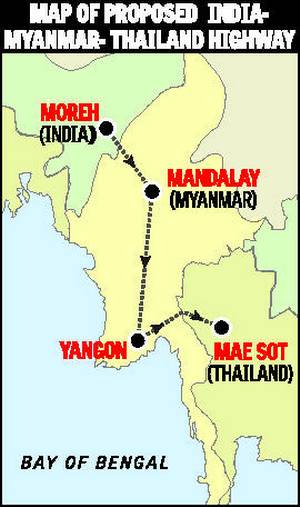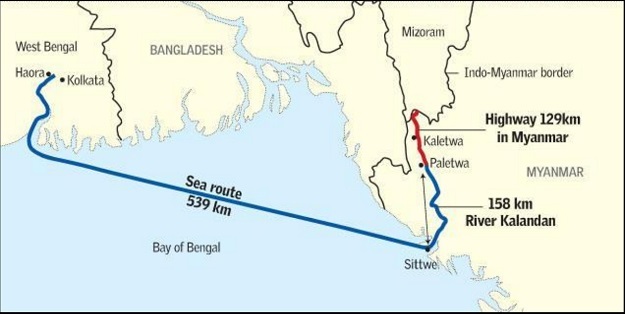India - ASEAN Relations
2022 NOV 25
Mains >
International relations > India and Global Regions > India & South East Asia
IN NEWS:
- Recently, the maiden India-ASEAN Defence Ministers’ Meeting was held at Siem Reap, Cambodia to commemorate the 30th Anniversary of India-ASEAN relations in 2022, which has also been designated as ‘ASEAN-India Friendship Year’.
MORE ON NEWS:
- The meeting was co-chaired by Defence Minister Shri Rajnath Singh and Deputy Prime Minister and Minister of National Defence of Cambodia General Tea Banh.
- The Defence Minister, in his address, highlighted the historic and robust ties that India shares with ASEAN countries and emphasised that the centrality of ASEAN in the Indo- Pacific region is the cornerstone of India’s Act East Policy.
- During the meeting, Defence Minister of India made two proposals for expanding the scope and the depth of the India-ASEAN defence relations. These include:
- India-ASEAN Initiative for Women in UN Peace Keeping Operations:
- The initiative includes conduct of tailor-made courses for women peacekeepers of ASEAN Member States at the Centre for United Nations Peacekeeping in India and conduct of a ‘Table Top Exercise’ in India for women officers from ASEAN incorporating facets of UN peacekeeping challenges.
- India-ASEAN Initiative on Marine Plastic Pollution:
- This initiative includes channelising of the energy of the youth towards addressing the critical issue of marine pollution. Shri Rajnath Singh informed the ASEAN members of the significant work done by the NCC in the cleaning of Indian beaches and raising awareness about plastic pollution in the Indian coastal community. He suggested coordination between the NCC and the equivalent youth organisations of ASEAN countries for a collective effort in this direction in the region.
ASEAN:
- The Association of Southeast Asian Nations (ASEAN) is a regional intergovernmental organization comprising ten countries in Southeast Asia.
- It was established in 1967 in Bangkok, Thailand, with the signing of the ASEAN Declaration (Bangkok Declaration).
- ASEAN promotes intergovernmental cooperation and facilitates economic, political, security, military, educational, and sociocultural integration among its members and other countries in Asia.
- It is headquartered in Jakarta (Indonesia).
----------------------------------
BACKGROUND OF INDIA AND ASEAN RELATIONS:
- 1950s and early 1960s:
- India aided in the decolonization of South East Asian countries
- 1960s to 1980s:
- India kept away from South East Asia due to internal issues like Indo China war. Also, India viewed ASEAN as a product of the Cold war.
- 1990s to 2010s:
- Following the end of cold war and 1991 economic reforms, India reached out to the ASEAN countries through “Look East Policy”.
- In 1995 it achieved the status of full dialogue partnership.
- In 1996, India became a full member of the ASEAN Regional Forum (ARF)
|
The ASEAN Regional Forum (ARF) is an important platform for security dialogue in the Indo-Pacific. It provides a setting in which members can discuss current security issues and develop cooperative measures to enhance peace and security in the region.
|
- 2010s to Present:
- India and ASEAN have been aggressively strengthening cooperation, through various initiatives like “Act East Policy” and Indo-ASEAN Summit.
- ASEAN-India relations were elevated to a Strategic Partnership in 2012.
- India-ASEAN relationship was elevated recently to Comprehensive Strategic Partnership during the ASEAN-India Summit held in Cambodia on November 12, 2022.
AREAS OF COOPERATION:
- Trade relations:
- India ASEAN Free Trade Agreement (AIFTA), signed in 2009, is the cornerstone of economic ties.
- ASEAN is India's fourth largest trading partner.
- Commodity trade between India and ASEAN region has reached 98.39 billion in the period April 2021- February 2022.
- Business & Investment:
- ASEAN is a major FDI source for India. Between 2000-2021 cumulative FDIs from ASEAN to India was $117.88 billion. These were mainly accounted for by Singaporean investments in India ($115 billion).
- ASEAN India-Business Council (AIBC) was set up in 2003 to act as a forum to bring key private sector players from India and ASEAN on a single platform for business networking and sharing of ideas.
- Socio-Cultural Cooperation:
- ASEAN nations and India share many cultural traits like Buddhism and Makar Sankranti festival.
- To boost People-to-People Interaction with ASEAN, initiatives such as Students Exchange Programme, Special Training Course for ASEAN diplomats, Exchange of Parliamentarians etc. are organized.
- Connectivity:
- India has made considerable progress in implementing the India-Myanmar-Thailand Trilateral Highway and the Kaladan Multimodal Project.
- A possible extension to India-Myanmar-Thailand Trilateral Highway to Cambodia, Lao PDR and Viet Nam is also under consideration.
- India has announced a Line of Credit of US$ 1 billion to promote projects that support physical and digital connectivity between India and ASEAN.
|
Myanmar-Thailand Trilateral Highway:
- It is a 1360 km long under-construction highway project, connecting Moreh in Manipur with Mae Sot, Thailand via Myanmar. India is undertaking construction of two sections of the Trilateral Highway in Myanmar.
--------------------------------
Kaladan Multimodal Project:
- Kaladan is a multi-modal transport project that involves shipping, Inland Water and road transport. It will connect Kolkata with Mizoram through the Bay of Bengal. The project is being piloted and funded by the Ministry of External Affairs. It is developed as an alternative route to North East India besides the Siliguri corridor.
----------------
|
- ASEAN-India Projects:
- India and ASEAN cooperate in the implementation of various projects in the fields of Agriculture, Science & Technology, Space, Environment & Climate Change, Human Resource Development, Capacity Building, New and Renewable Energy, Tourism, People-to-People contacts and Connectivity etc.
- Eg: ASEAN-India Fellowships for Higher Agricultural Education in India and ASEAN and Exchange of Agriculture Scientists.
- Funds:
- ASEAN-India Cooperation Fund: To support implementation of the ASEAN-India Plans of Action, envisaging cooperation in a range of capacity building programmes in the political, economic and socio-cultural spheres.
- ASEAN-India S&T Development Fund (AISTDF): A US$ 1 million contribution from India to promote joint collaborative R&D research projects in Science & Technology
- ASEAN-India Green Fund: To support collaboration activities relating to environment and climate change. Some of the areas identified for collaboration are energy efficiency, clean technologies, renewable energy, biodiversity conservation and environmental education.
- Strategic cooperation:
- ASEAN Post Ministerial Conference (ASEAN PMC) and the ASEAN Defense Ministerial Meeting-Plus (ADMM-Plus) provide a platform to deliberate on the security issues such as piracy, illegal migration, trafficking of drugs, arms, and human and maritime terrorism.
- There are also maritime exercises with the navies of ASEAN countries, information-sharing initiatives, and defense agreements with individual ASEAN countries. Eg: India-Thailand CORPAT.
- Defence cooperation:
- India has initiated measures to improve arms sale with ASEAN countries like Vietnam and Philippines. Eg: Philippines recently (January 2022) approved a USD 374 million purchase of BrahMos shore-based anti-ship missile system.
- Technological cooperation:
- ISRO is pursuing a proposal to support ASEAN countries to receive and process data from Indian remote sensing satellites (RESOURCESAT-2 and OCEANSAT-2) and also to provide training in space science, technology and applications
- Delhi Dialogue:
- India has an annual Track 1.5 event Delhi Dialogue, for discussing politico-security and economic issues between ASEAN and India.
WHY INDIA NEEDS ASEAN:
- Significant trade & Commercial relations:
- ASEAN is a major destination for India’s service sectors and a major source for quality foreign investments. Also, major Indian companies have made significant investments in ASEAN countries, like ONGC Videsh’s investment in Vietnam.
- For development of North East India:
- ASEAN provides a second route for India to access North Eastern India. This facilitates in development and as well as improving India’s strategic concerns in the region. Eg. Kaladan Multimodal Project.
- To counter Chinese expansion:
- With USA gradually receding from Asia, India needs strong partners like ASEAN countries to counter china’s aggressive growth in various spheres such as maritime security, global trade and maritime border disputes.
- Maritime freedom:
- Given the strategic location of ASEAN countries along critical sea lanes, engagement with them forms an integral part of India’s vision of a free, open, inclusive, and peaceful Indo-Pacific built on rules-based order.
- To face rising politico-security challenges:
- Traditional and non-traditional challenges like climate change, terrorism, refugee crisis and radicalization has been on the rise. These are common security threats to both the societies.
- Support Indian initiatives:
- Cooperation of ASEAN is key to ensure the success of Indian initiatives like Act East policy, smart city, Make in India and Asia-Africa growth corridor. Given its cultural links, ASEAN is also a vital link in India’s soft diplomacy strategies.
- Emerging market:
- India is a major destination for agricultural and industrial products from ASEAN. Also, India’s favorable demographic dividend will be essential for the ASEAN nations in the near future.
- For global reforms:
- ASEAN is a global powerhouse and an influential organization, and, like India, they have been voicing for reforms in forums like UN Security Council and World Trade Organization.
- Diaspora:
- Southeast Asia has a strong Indian diaspora. Approximately 8% of Malaysia’s population is of Indian descent, and approximately 9% of Singapore’s population is of Indian descent.
- Elevate India’s status as a global power:
- Cooperation with ASEAN enhances India’s position as a major geopolitical force. For instance, membership in the ARF gave India the chance to share a high table with big powers like the United States, China, and Russia, alongside ASEAN, on security issues in the Indo-Pacific region.
CHALLENGES TO STRONGER COOPERATION:
- Large Trade deficit:
- Trade imbalance between India and ASEAN remains skewed in ASEAN’s favour. Due to the FTA, the trade deficit rose from around $5 billion in FY11 to USD 21.8 billion in FY19. This trade deficit was one of the reasons that India exited the ASEAN-led Regional Comprehensive Economic Partnership (RCEP) trade agreement last year (2021).
- Issues in FTA:
- Indian lawmakers have expressed concern that despite trade agreements, India has not received sufficient market access and is facing steep import tariffs in ASEAN.
- Balancing China:
- China is the largest trading partner for both India and ASEAN. In terms of military capabilities too, China is better equipped. This trade dependency on China as well as its military superiority has led to an approach of cautious engagement, largely on ASEAN’s part.
- Delays in connectivity projects:
- Long delay in completion of connectivity projects—for instance, the trilateral India-Myanmar-Thailand (IMT) highway was expected to be finished in 2016 but has not due to bureaucratic and procedural issues on the Indian side.
- Issues within ASEAN:
- The members’ political systems are mixed with democracies, communist, and authoritarian states and are divided over major issues of human rights, such as Rohingya issue with Myanmar and human rights violations in Philippines.
WAY FORWARD:
A stronger partnership and enhanced cooperation should be prioritised by both sides if the full potential of this engagement is to be realised.
- Enhance India’s trade relations with the South East and East Asian markets, through areas such as blue economy and sustainable development.
- Speed up work on long-gestating connectivity projects, such as the India-Myanmar-Thailand trilateral highway, and building new trade and transport linkages with all the ASEAN states
- For India to be a regional power as it claims to be, continuing to enhance its relations with ASEAN in all spheres must be a priority. Given the present geopolitical circumstances, India needs to step up its role in the region.
- India can also look into the establishment of dedicated departments under central ministries to facilitate better cooperation with ASEAN.
- Cooperate in a post-covid world to initiate global governance reforms and combating climate change.
With frequent aggressions from China, it is pertinent that India find more like-minded nations interested in working together to protect regional peace and stability. In this context, ASEAN fits the bill perfectly.
PRACTICE QUESTION:
Q. ASEAN is central to India’s vision for the Indo-Pacific region in terms of stability, security and growth. Elaborate?
